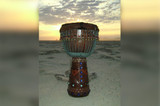We Love Egg Shakers!
Egg shakers are a versatile percussion instrument that can be used at all ages and skill levels to create a wonderfully rich musical rhythm with little to no experience. There are several types of egg shakers made from a variety of materials from natural gourds to plastic eggs filled with steel ball bearings.
The best part of egg shakers,  aside from the sound, is that they are easy to hold and use. Typically, you can hold anywhere from one to three egg shakers in your dominant hand depending on how big they are. Most egg shakers come in a two to two and a half inch size, but some are as small as a one-inch diameter, and others as large as a four-inch diameter. Most percussionists prefer the midsize range because several can be held in one hand to rotate and shake at the same time for a richer sound with many layers.
aside from the sound, is that they are easy to hold and use. Typically, you can hold anywhere from one to three egg shakers in your dominant hand depending on how big they are. Most egg shakers come in a two to two and a half inch size, but some are as small as a one-inch diameter, and others as large as a four-inch diameter. Most percussionists prefer the midsize range because several can be held in one hand to rotate and shake at the same time for a richer sound with many layers.
The egg shape is easy to cup in a player's hand, and with just a simple repetitive flick of the wrist, you will have an instant, distinctive sound and rhythm that provides an excellent percussive accompaniment to many other instruments, including the djembe. By holding more than one egg shaker in your dominant hand, you can roll them together for a softer swishing sound created by the beads, or simply hold them together for a stronger distinct shaker sound.
Egg shakers are often used with children when first teaching them about rhythm. Egg shakers come in a wide variety of colors, and instantly appeal to kids. They are wonderful because they are a welcoming instrument, and just about anyone can play them without any trouble, creating sounds that gives them confidence in their ability to play a rhythm.
Egg shakers tend to give a softer, although very distinct, sound than metal shakers. The combination of a molded plastic exterior with either plastic or steel beads provides options for sounds that are softer and quieter than metal shakers, which always have more ping sound to them. By adjusting how fast or slow you play the egg shaker, you can create different musical moods from the sound of a softly rushing brook over rocks, to a sharp, continuous throbbing that really adds to musical interest.
Recent Posts
-
What is the Best Size Djembe for Beginners?
If you're new to the world of percussion and interested in learning the djembe, you're in for a t …16th Jul 2024 -
The Benefits of Becoming a Drumming Teacher: Transforming Passion into Profession
Why become a drumming teacher? Becoming a drumming teacher is an excellent way to share your pas …22nd May 2024 -
What Makes the Djembe Drum a Spiritual Instrument in African Music?
Origin and history of the Djembe drum The Djembe drum originates from West Africa and holds sign …16th May 2024



